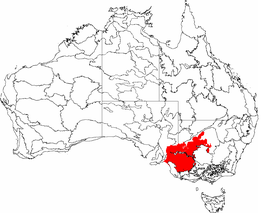Murray Darling Depression
| Murray Darling Depression Murray-Darling woodlands and mallee | |
|---|---|
 The IBRA regions, with Murray Darling Depression in red | |
| Ecology | |
| Realm | Australasian |
| Biome | Mediterranean forests, woodlands, and scrub |
| Borders | |
| Geography | |
| Area | 197,900 km2 (76,400 sq mi) |
| Country | Australia |
| States | |
| Conservation | |
| Conservation status | Critical/endangered |
| Protected | 31,000 km² (15%)[1] |
The Murray Darling Depression , also known as the Murray-Darling woodlands and mallee, is a biogeographic region and an ecoregion in southeastern Australia consisting of a wooded plain through which flow two of Australia's biggest rivers, the Murray and the Darling.
Location and description
The plains have a dry Mediterranean climate with more rainfall (400mm per year) in the south than in the drier north (250mm). Fires are common in the hot dry summers.[2]
Flora
The original vegetation of the basin was mallee eucalyptus woodlands with thicker black box (Eucalyptus largiflorens) and river red gum (Eucalyptus camaldulensis) woodland on riverbanks but most has been cleared for wheat farming and pasture. The flora of the plain need to be adapted to renew itself after the summer droughts and accompanying fires.
Fauna
Wildlife of the area includes large numbers of lizards, ants, and honeyeater birds (especially of the Lichenostomus and Meliphaga genera). Lizards include species of skink (especially of Ctenotus, Egernia, and Lerista genera). Ants include species of Iridomyrmex, carpenter ants, and Melophorus. Endangered species include the black-eared miner bird (Manorina melanotis) and the malleefowl (Leipoa ocellata).
Threats and preservation
Although much of the plain was cleared in the past (missing reference), this is now carefully controlled (missing reference) and areas of protected natural vegetation remain, especially in the large Ngarkat Conservation Park - Big Desert Wilderness Park on the South Australia-Victoria border. Threats to habitats today come from introduced weeds, over-salination of rivers as water is drawn off for irrigation, over-use of fire to remove dry shrubs and prevent forest fires and overgrazing by introduced goats and rabbits.
References
- ^ Dinerstein, Eric; Olson, David; et al. (June 2017). "An Ecoregion-Based Approach to Protecting Half the Terrestrial Realm". BioScience. 67 (6): 534–545. doi:10.1093/biosci/bix014.
{{cite journal}}: CS1 maint: date and year (link) Supplemental material 2 table S1b. - ^ "Murray-Darling woodlands and mallee". Terrestrial Ecoregions. World Wildlife Fund.
